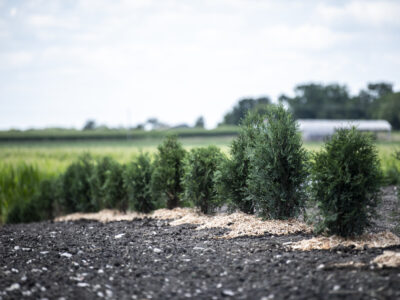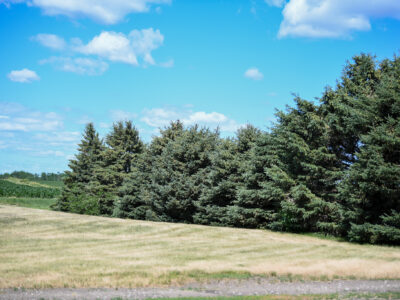How Windbreaks Work
04-16-2012 in Green Farmstead Partner
Adapted from: “How Windbreaks Work” by James R. Brandle, University of Nebraska-Lincoln and Sherman Finch, Soil Conservation Service.
To read the full article, visit:
Windbreaks are barriers used to reduce and redirect wind. They usually consist of trees and shrubs, but may also be perennial or annual crops and grasses, fences, or other materials. The reduction in wind speed behind a windbreak modifies the environmental conditions or micro-climate in the sheltered zone.
As wind blows against a windbreak, air pressure builds up on the windward side (the side towards the wind), and large quantities of air move up and over the top or around the ends of the windbreak. Windbreak structure – height, density, number of rows, species composition, length, orientation, and continuity – determines the effectiveness of a windbreak in reducing wind speed and altering the microclimate.
Effect of height
Windbreak height (H) is the most important factor determining the downwind area protected by a windbreak. This value varies from windbreak to windbreak, and increases as the windbreak matures. In multiple row windbreaks, the height of the tallest tree-row determines the value of H.
On the windward side of a windbreak, wind speed reductions are measurable upwind for a distance of two to five times the height of the windbreak (2H to 5H). On the leeward side (the side away from the wind), wind speed reductions occur up to 30H downwind of the barrier. For example, in a windbreak where the tallest trees are 30 ft, lower wind speeds are measurable for 60 ft to 150 ft on the windward side, and up to 900 ft on the leeward side. Within this protected zone, the structural characteristics of a windbreak, especially density, determine the extent of wind speed reductions.
Effect of Density
Windbreak density is the ratio of the solid portion of the barrier to the total area of the barrier. Wind flows through the open portions of a windbreak, thus the more solid a windbreak, the less wind passes through. Low pressure develops on the leeward side of very dense windbreaks. This low pressure area behind the windbreak pulls air coming over the windbreak downward, creating turbulence and reducing protection downwind. As density decreases, the amount of air passing through the windbreak increases, moderating the low pressure and turbulence, and increasing the length of the downwind protected area. While this protected area is larger, the wind speed reductions are not as great. By adjusting windbreak density, different wind flow patterns and areas of protection are established.
In designing a windbreak, density should be adjusted to meet landowner objectives. A windbreak density of 40 to 60 percent provides the greatest downwind area of protection and provides excellent soil erosion control. To get even distribution of snow across a field, densities of 25 to 35 percent are most effective, but may not provide sufficient control of soil erosion.
Windbreaks designed to catch and store snow in a confined area usually have several rows, and densities in the range of 60 to 80 percent. Farmsteads and livestock areas needing protection from winter winds require multiple row windbreaks with high densities. In these cases, wind speed reductions are greater but the protected area is smaller.
The number of rows, the distance between trees, and species composition are factors controlling windbreak density. Increasing the number of windbreak rows or decreasing the distance between trees increases density and provides a more solid barrier to the wind. The species chosen for the windbreak will determine height as well as density, and will influence the length of the sheltered area.
The interaction of height and density determines the degree of wind speed reduction, and ultimately the length of the protected area. For a given height, the protected area usually increases as density increases. However, if density is below 20 percent, the windbreak does not provide useful wind reductions. If density is above 80 percent, excessive leeward turbulence may reduce windbreak effectiveness beyond 8H.
The cross-sectional shape of windbreaks with equal densities has minimal influence on wind velocities within 10H of the leeward side of a barrier. Beyond 10H, straight sides provide slightly more protection than slanted sides, because more wind passes through the trees, and extends the protected area farther to the leeward.
Effect of orientation
Windbreaks are most effective when oriented at right angles to prevailing winds. The purpose and design of each windbreak is unique, thus the orientation of individual windbreaks depends on the design objectives.
Farmsteads and feedlots usually need protection from cold winds and blowing snow or dust. Orienting these windbreaks perpendicular to the troublesome winter wind direction provides the most useful protection.
Although wind may blow predominantly from one direction for a season, it rarely blows exclusively from that direction. As a result, protection is not equal for all areas on the leeward side of a windbreak. As the wind changes direction and is no longer blowing directly against the windbreak, the protected area decreases (See Figure 2). The use of multiple-leg windbreaks provides a larger protected area than a single windbreak. Again, individual placement depends on the site, the wind direction(s), and the design objectives.
Effect of Length
Although the height of a windbreak determines the extent of the protected area downwind, the length of a windbreak determines the amount of total area receiving protection. For maximum efficiency, the uninterrupted length of a windbreak should exceed the height; by at least 10:1. This ratio reduces the influence of end-turbulence on the total protected area.
The continuity of a windbreak also influences its efficiency. Gaps in a windbreak become funnels that concentrate wind flow, creating areas on the downwind side of the gap in which wind speeds often exceed open field wind velocities (Figure 3). Where there are gaps, the effectiveness of the windbreak is diminished. Lanes or field accesses through windbreaks should be located to minimize this effect or if possible avoided altogether.
Microclimate modifications
The reduction in wind velocity behind a windbreak leads to a change in the microclimate within the protected zone. Temperature and humidity levels usually increase, decreasing evaporation and plant water loss. Actual temperature modifications for a given windbreak depend on windbreak height, density, orientation, and time of day. Daily air temperatures within ten times the height (10H) leeward of a windbreak, are generally several degrees higher than temperatures in the open. Beyond 10H, air temperatures near the ground tend to be cooler during the day. On most nights, temperatures near the ground in sheltered areas (0H to 30H) are slightly warmer than in the open. However, on very calm nights, sheltered areas may be several degrees cooler than open areas.
Soil temperatures in sheltered areas are usually slightly warmer than in unsheltered areas. Taking advantage of these warmer temperatures may allow earlier planting and germination in areas with short growing seasons. In the area next to an east-west windbreak soil temperatures are significantly higher on the south side due to heat reflected by the windbreak. On the north side of an east-west windbreak, soil temperatures, especially in the early spring, are lower due to shading by the windbreak. These cooler temperatures may reduce the rate of snow melt, and cause problems with field access in early spring.
Relative humidity in sheltered areas is 2-4% higher than in open areas, depending on windbreak density. Higher humidity decreases the rate of plant water use, so production is more efficient than in unsheltered areas. However, if the windbreak is too dense, and humidity levels get too high, diseases may become a problem in some crops.
Heat loss due to wind-chill is reduced on the leeward side of a windbreak. Moderation of the chill factor is most important in farmstead and livestock windbreaks where humans and other animals readily notice increased energy efficiency.
Most windbreak benefits come about indirectly because of changes in the microclimate of the sheltered zone. One exception is the direct benefit of reducing wind speed to control soil erosion. A well designed windbreak can reduce soil erosion to near zero within 10H of the leeward side of the tree row.
Summary
Windbreaks reduce wind speed on both the leeward and windward sides. The resulting reductions in wind speed lead to moderation of the microclimate in these protected zones. With careful planning, and in consultation with local professionals, these changes in micro-climate can be used to create desirable environments for growing crops, raising livestock, and protecting the living and working areas.



